Lindsay McCormick is a Program Manager.

EDF report identifies emerging market for personal chemical exposure monitoring technologies through a first-of-its-kind analysis.
When I first started working at EDF in 2014, I learned a statistic that shocked me: We have human exposure data on less than 4% of the roughly half-million chemicals in commerce.[1] In other words, we know next to nothing about the vast majority of chemical exposures that people were experiencing on a daily basis.
Chemicals are found in nearly all commercial products and serve a foundational role in our economy. Yet this ubiquity comes with its downsides, as some chemicals are hazardous and can find their way into our environment and ultimately end up in our water, land, and air—and in our bodies. Exposure to certain chemical substances have been linked to a variety of adverse health impacts, including reproductive harm, disruption of normal hormone activity, and impaired neurological development in children.
The lack of knowledge about chemical exposures poses a major problem: Without better information on exactly which chemicals individuals are exposed to every day, it is challenging to develop effective policies and interventions to reduce harmful exposures and protect health.
Disrupting the status quo
But what if anyone could use a simple home-delivered kit or wearable device to reveal the chemicals in their environment—and in their body? Such technologies could make the invisible visible—providing individuals, as well as policy makers, businesses, health professionals, and others, with critical information needed to accelerate reductions in the public’s exposure to hazardous chemicals.
In 2017, EDF pursued a Year of Innovation to better understand opportunities to advance the market for personal chemical exposure monitors (PCEMs) – with the ultimate goal of improving public health. As part of this effort, we conducted interviews and convened an expert workshop to identify bottlenecks in the development and use of such technologies.
We learned that a significant gap exists between the demand and promise of PCEM technologies and the current cost or scalability of many of the available technologies today. Experts noted that while there is significant qualitative or anecdotal evidence of demand, a quantitative understanding of the potential market for these technologies is needed to drive a robust market.
EDF took that lesson and embarked on a two-part study to fill this gap.

